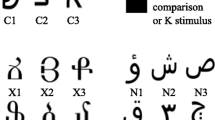Abstract
The emergence of symmetric matching to sample was studied in fourteen 2-year-old children. Three two-choice, arbitrary matching-to-sample tasks were arranged successively. Each task was followed by a test of symmetric responding. The behavior required by the tasks was taught with sample stimulus-control shaping (Zygmont, Lazar, Dube, & McIlvane, 1992). Five children did not learn identity matching, which is required for sample stimulus-control shaping. Two others showed a deterioration of baseline responding when the first test was given. The participation of these seven children was stopped. The others showed symmetric responding on all tests. These results demonstrate generalized symmetric matching to sample (one aspect of stimulus equivalence) in 2-year-old children.
Similar content being viewed by others
References
AUGUSTSON, K. G., DOUGHER, M. J. (1992). Teaching conditional discrimination to young children: Some methodological successes and failures. Experimental Analysis of Human Behavior Bulletin, 9, 21–24.
BAER, D. M., DEGUCHI, H. (1985). Generalized imitation from a radical-behavioral viewpoint. In S. Reiss & R. Bootzin (Eds.), Theoretical issues in behavior therapy (pp. 179–217). New York: Academic Press.
BARNES, D., BROWNE, M., SMEETS, R., & ROCHE, B. (1995). A transfer of functions and a conditional transfer of functions through equivalence relations in three- to six-year-old children. The Psychological Record, 45, 405–430.
BARNES, D., MCCULLAGH, P. D., KEENAN, M. (1990). Equivalence class formation in non-hearing impaired children and hearing impaired children. Analysis of Verbal Behavior, 8, 19–30.
BOELENS, H. (1994). A traditional account of stimulus equivalence. The Psychological Record, 44, 587–605.
DEVANY, J. M., HAYES, S. C., NELSON, R. O. (1986). Equivalence-class formation in language-able and language-disabled children. Journal of the Experimental Analysis of Behavior, 46, 243–257.
DUGDALE, N., LOWE, C. F. (1990). Naming and stimulus equivalence. In D. E. Blackman & H. Lejeune (Eds.), Behaviour analysis in theory and practice: Contributions and controversies (pp. 115–138). Hove: Lawrence Erlbaum Associates.
HAYES, S. C., HAYES, L. J. (1989). The verbal action of the listener as a basis for rule governance. In S. C. Hayes (Ed.), Rule-governed behavior: Cognition, contingencies and instructional control (pp. 153–190). New York: Plenum Press.
HORNE, P. J., LOWE, C. F. (1996). On the origins of naming and other symbolic behavior. Journal of the Experimental Analysis of Behavior, 65, 185–241.
LOWE, C. F., BEASTY, A. (1987). Language and the emergence of equivalence relations: A developmental study. Bulletin of the British Psychological Society, 40, A42.
MCILVANE, W. J., DUBE, W. V., KLEDARAS, J. B., ENNACO, F. M., STODDARD, L. T (1990). Teaching relational discrimination to individuals with mental retardation: Some problems and possible solutions. American Journal on Mental Retardation, 95, 283–296.
PILGRIM, C., CHAMBERS, L., GALIZIO, M. (1995). Reversal of baseline relations and stimulus equivalence: II. Children. Journal of the Experimental Analysis of Behavior, 63, 239–254.
REGLER, H. C., BAER, D. M. (1989). A developmental analysis of rule-following. In H. W. Reese (Ed.), Advances in child development and behavior, Vol. 21 (pp. 191–219). New York: Academic Press.
SAUNDERS, R. R., GREEN, G. (1992). The nonequivalence of behavioral and mathematical equivalence. Journal of the Experimental Analysis of Behavior, 57, 227–241.
SHERMAN, J. A. (1971). Imitation and language development. In H. W. Reese (Ed.), Advances in Child Development and Behavior, Vol. 6 (pp. 239–272). New York: Academic Press.
SIDMAN, M., TAILBY, W. (1982). Conditional discrimination vs. matching to sample: An expansion of the testing paradigm. Journal of the Experimental Analysis of Behavior, 37, 5–22.
SIDMAN, M., WILLSON-MORRIS, M., KIRK, B. (1986). Matching-to-sample procedures and the development of equivalence relations: The role of naming. Analysis and Intervention in Developmental Disabilities, 6, 1–19.
ZYGMONT, D. M., LAZAR, R. M., DUBE, W. V., MCILVANE, W. J. (1992). Teaching arbitrary matching via sample stimulus-control shaping to young children and mentally retarded individuals: A methodological note. Journal of the Experimental Analysis of Behavior, 57, 109–117.
Author information
Authors and Affiliations
Corresponding author
Additional information
We thank the staff and caretakers of day-care centers Rupsje Nooitgenoeg, Leiden; Flap, Gouda; and ‘t Stampertje, Bodegraven, for their kind cooperation in this study. Also, we are indebted to Paul Smeets and Giulio Lancioni for their comments on previous versions of the manuscript.
Rights and permissions
About this article
Cite this article
Boelens, H., Van Den Broek, M. & Van Klarenbosch, T. Symmetric Matching to Sample in 2-Year-Old Children. Psychol Rec 50, 293–304 (2000). https://doi.org/10.1007/BF03395357
Published:
Issue Date:
DOI: https://doi.org/10.1007/BF03395357




